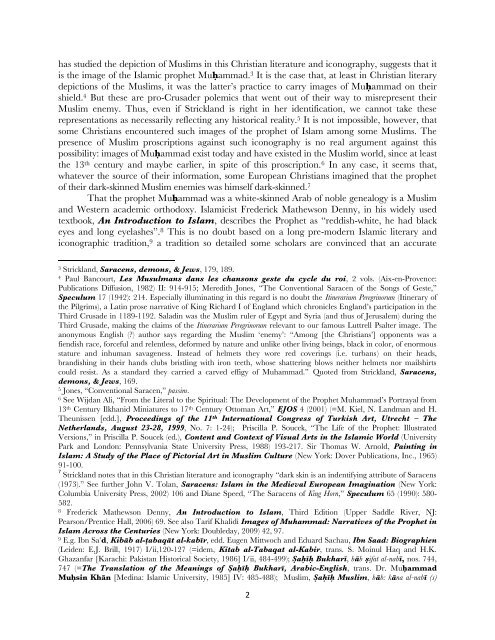Muhammad_Article.349.. - Dr. Wesley Muhammad
Muhammad_Article.349.. - Dr. Wesley Muhammad
Muhammad_Article.349.. - Dr. Wesley Muhammad
You also want an ePaper? Increase the reach of your titles
YUMPU automatically turns print PDFs into web optimized ePapers that Google loves.
has studied the depiction of Muslims in this Christian literature and iconography, suggests that it<br />
is the image of the Islamic prophet MuÈammad. 3 It is the case that, at least in Christian literary<br />
depictions of the Muslims, it was the latter’s practice to carry images of MuÈammad on their<br />
shield. 4 But these are pro-Crusader polemics that went out of their way to misrepresent their<br />
Muslim enemy. Thus, even if Strickland is right in her identification, we cannot take these<br />
representations as necessarily reflecting any historical reality. 5 It is not impossible, however, that<br />
some Christians encountered such images of the prophet of Islam among some Muslims. The<br />
presence of Muslim proscriptions against such iconography is no real argument against this<br />
possibility: images of MuÈammad exist today and have existed in the Muslim world, since at least<br />
the 13 th century and maybe earlier, in spite of this proscription. 6 In any case, it seems that,<br />
whatever the source of their information, some European Christians imagined that the prophet<br />
of their dark-skinned Muslim enemies was himself dark-skinned. 7<br />
That the prophet MuÈammad was a white-skinned Arab of noble genealogy is a Muslim<br />
and Western academic orthodoxy. Islamicist Frederick Mathewson Denny, in his widely used<br />
textbook, An Introduction to Islam, describes the Prophet as “reddish-white, he had black<br />
eyes and long eyelashes”. 8 This is no doubt based on a long pre-modern Islamic literary and<br />
iconographic tradition, 9 a tradition so detailed some scholars are convinced that an accurate<br />
3 Strickland, Saracens, demons, & Jews, 179, 189.<br />
4 Paul Bancourt, Les Musulmans dans les chansons geste du cycle du roi, 2 vols. (Aix-en-Provence:<br />
Publications Diffusion, 1982) II: 914-915; Meredith Jones, “The Conventional Saracen of the Songs of Geste,”<br />
Speculum 17 (1942): 214. Especially illuminating in this regard is no doubt the Itinerarium Peregrinorum (Itinerary of<br />
the Pilgrims), a Latin prose narrative of King Richard I of England which chronicles England’s participation in the<br />
Third Crusade in 1189-1192. Saladin was the Muslim ruler of Egypt and Syria (and thus of Jerusalem) during the<br />
Third Crusade, making the claims of the Itinerarium Peregrinorum relevant to our famous Luttrell Psalter image. The<br />
anonymous English (?) author says regarding the Muslim ‘enemy’: “Among [the Christians’] opponents was a<br />
fiendish race, forceful and relentless, deformed by nature and unlike other living beings, black in color, of enormous<br />
stature and inhuman savageness. Instead of helmets they wore red coverings (i.e. turbans) on their heads,<br />
brandishing in their hands clubs bristling with iron teeth, whose shattering blows neither helmets nor mailshirts<br />
could resist. As a standard they carried a carved effigy of <strong>Muhammad</strong>.” Quoted from Strickland, Saracens,<br />
demons, & Jews, 169.<br />
5 Jones, “Conventional Saracen,” passim.<br />
6 See Wijdan Ali, “From the Literal to the Spiritual: The Development of the Prophet <strong>Muhammad</strong>’s Portrayal from<br />
13 th Century Ilkhanid Miniatures to 17 th Century Ottoman Art,” EJOS 4 (2001) (=M. Kiel, N. Landman and H.<br />
Theunissen [edd.], Proceedings of the 11 th International Congress of Turkish Art, Utrecht – The<br />
Netherlands, August 23-28, 1999, No. 7: 1-24); Priscilla P. Soucek, “The Life of the Prophet: Illustrated<br />
Versions,” in Priscilla P. Soucek (ed.), Content and Context of Visual Arts in the Islamic World (University<br />
Park and London: Pennsylvania State University Press, 1988) 193-217. Sir Thomas W. Arnold, Painting in<br />
Islam: A Study of the Place of Pictorial Art in Muslim Culture (New York: Dover Publications, Inc., 1965)<br />
91-100.<br />
7 Strickland notes that in this Christian literature and iconography “dark skin is an indentifying attribute of Saracens<br />
(1973).” See further John V. Tolan, Saracens: Islam in the Medieval European Imagination (New York:<br />
Columbia University Press, 2002) 106 and Diane Speed, “The Saracens of King Horn,” Speculum 65 (1990): 580-<br />
582.<br />
8 Frederick Mathewson Denny, An Introduction to Islam, Third Edition (Upper Saddle River, NJ:<br />
Pearson/Prentice Hall, 2006) 69. See also Tarif Khalidi Images of <strong>Muhammad</strong>: Narratives of the Prophet in<br />
Islam Across the Centuries (New York: Doubleday, 2009) 42, 97.<br />
9 E.g. Ibn Sa#d, Kib§b al-ãabaq§t al-kabÊr, edd. Eugen Mittwoch and Eduard Sachau, Ibn Saad: Biographien<br />
(Leiden: E.J. Brill, 1917) I/ii,120-127 (=idem, Kitab al-Tabaqat al-Kabir, trans. S. Moinul Haq and H.K.<br />
Ghazanfar [Karachi: Pakistan Historical Society, 1986] I/ii, 484-499); ‘aÈÊÈ BukharÊ, b§b ßifat al-nabÊ, nos. 744,<br />
747 (=The Translation of the Meanings of ‘aÈÊÈ BukharÊ, Arabic-English, trans. <strong>Dr</strong>. MuÈammad<br />
MuÈsin Kh§n [Medina: Islamic University, 1985] IV: 485-488); Muslim, ‘aÈÊÈ Muslim, b§b: k§na al-nabÊ (s)<br />
2

















